 This salad of curly endive with bacon is a French bistro classic and it’s one of my favorites. I often serve it to friends at dinner parties, usually followed by another bistro dish, for example boeuf bourguignon or Provençal chicken with pastis. This is what is known over here as cuisine à la bonne franquette — casual, unfussy cooking (more on that below). Indeed, to make this salad you need only two main ingredients: the lettuce and the bacon.
This salad of curly endive with bacon is a French bistro classic and it’s one of my favorites. I often serve it to friends at dinner parties, usually followed by another bistro dish, for example boeuf bourguignon or Provençal chicken with pastis. This is what is known over here as cuisine à la bonne franquette — casual, unfussy cooking (more on that below). Indeed, to make this salad you need only two main ingredients: the lettuce and the bacon.
Salade frisée aux lardons / Salad of curly endive with bacon
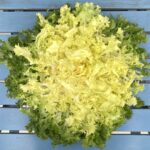 Let’s start with the lettuce. Salade frisée is displayed proudly in French farmers markets, its yellow heart framed by a dark green crown. This type of salad is huge. It can measure up to two feet (60 cm) in diameter when spread open. When I took the photo at right, it virtually covered the picnic table on my veranda. So unless you are cooking for an army, you won’t need all of it for your salad. What to do with the rest? Either a repeat performance or you can use it to make Italian lettuce soup, a recipe I hope to post one day soon.
Let’s start with the lettuce. Salade frisée is displayed proudly in French farmers markets, its yellow heart framed by a dark green crown. This type of salad is huge. It can measure up to two feet (60 cm) in diameter when spread open. When I took the photo at right, it virtually covered the picnic table on my veranda. So unless you are cooking for an army, you won’t need all of it for your salad. What to do with the rest? Either a repeat performance or you can use it to make Italian lettuce soup, a recipe I hope to post one day soon.
 Now the bacon. In France lardons, or bacon sticks, are sold precut in supermarkets. But for best results with this salad, it’s preferable to start with a thick strip of bacon — about 1/3 inch (1 cm) — and cut the lardons yourself. The flavor and texture are better, and your guests will appreciate it. If that’s not possible where you live, buy thick-cut bacon strips and chop them. My advice: be generous with the bacon. It’s the star of the show.
Now the bacon. In France lardons, or bacon sticks, are sold precut in supermarkets. But for best results with this salad, it’s preferable to start with a thick strip of bacon — about 1/3 inch (1 cm) — and cut the lardons yourself. The flavor and texture are better, and your guests will appreciate it. If that’s not possible where you live, buy thick-cut bacon strips and chop them. My advice: be generous with the bacon. It’s the star of the show.
What else? Plenty of garlic in the dressing of your choice. I prefer a tangy lemon-olive oil sauce. Balsamic vinaigrette and mustard vinaigrette are also popular. Some chefs incorporate melted bacon fat into the sauce, but I don’t as I find that a bit heavy.
To make the salad, you prepare the sauce in the bottom of a large salad bowl, stir in the minced garlic and pile the chopped and washed leaves on top. Just before serving, you fry the bacon. The salad comes to the table with the bacon piping hot.
There are many variations on this basic salad. Croutons are often added. Sometimes the salad is topped with a poached or soft-boiled egg. I’ve seen other additions as well. But personally I prefer to omit these extras. I find that the salad is at its best without them.
As for à la bonne franquette, the expression derives from the word franc, meaning ‘frank’. In the 17th century, Molière used à la franquette, in the sense of speaking frankly, in his farce on French medicine, ‘The Doctor Inspite of Himself’. In the 16th century, according to a Canadian government web site, à la franquette, evoking simplicity, was used in contrast with à la française (‘French style’), meaning ‘with ceremony’ or ‘luxuriously’.
While researching the origin of the term, I stumbled across some amusing translations of the word ‘France’, which I had mistakenly thought was etymologically linked to the word ‘franc‘. It appears that in the Navajo language, France is known as Dáághahii Dineʼé bikéyah, or ‘the land of those who wear the mustache’, while in Maori, France is known as Wīwī, which derives from — you guessed it — ‘Oui, oui‘.
Happy cooking.

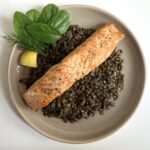 Roasted salmon on a bed of spicy lentils is a dish that delivers the comfort we crave in winter without too much heft. Here, the dish is paired with spinach for a combination that’s as pleasing to the eye as to the palette. I made this dish last week during a cold snap in Paris — below-freezing temperatures and snow that didn’t melt for days, a rare event over here. After fireside suppers featuring heavier winter dishes, the salmon made a welcome change.
Roasted salmon on a bed of spicy lentils is a dish that delivers the comfort we crave in winter without too much heft. Here, the dish is paired with spinach for a combination that’s as pleasing to the eye as to the palette. I made this dish last week during a cold snap in Paris — below-freezing temperatures and snow that didn’t melt for days, a rare event over here. After fireside suppers featuring heavier winter dishes, the salmon made a welcome change.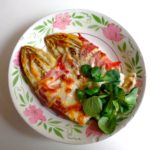 As the cold is bound to return, both here and elsewhere, I thought I’d share some of the dishes I’ve been making to cheer this frigid season, in hopes of inspiring you. Over the last month or so I’ve served:
As the cold is bound to return, both here and elsewhere, I thought I’d share some of the dishes I’ve been making to cheer this frigid season, in hopes of inspiring you. Over the last month or so I’ve served: 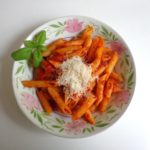 After all that entertaining, I slowed down this month, mainly cooking for my daugher and myself, as well as a couple of guests. So far I’ve served
After all that entertaining, I slowed down this month, mainly cooking for my daugher and myself, as well as a couple of guests. So far I’ve served  A classic French bistro dish that’s particularly pleasant in winter is leeks in vinaigrette sauce. It’s incredibly quick and easy to make at home, and there are many variations: with mustard vinaigrette, balsamic vinaigrette, lemon vinaigrette, topped with shallots or not, topped with herbs or not, topped with chopped egg or not etc. etc. In today’s recipe, the leeks are steamed, then topped with mustard vinaigrette, chopped shallot and chopped parsley.
A classic French bistro dish that’s particularly pleasant in winter is leeks in vinaigrette sauce. It’s incredibly quick and easy to make at home, and there are many variations: with mustard vinaigrette, balsamic vinaigrette, lemon vinaigrette, topped with shallots or not, topped with herbs or not, topped with chopped egg or not etc. etc. In today’s recipe, the leeks are steamed, then topped with mustard vinaigrette, chopped shallot and chopped parsley. The recipe for these fluffy little pancakes came to me via my Grandma Anne, whose family hailed from a small Jewish village in Ukraine. She called them ‘cottage cheese pancakes’, which always baffled me since cottage cheese has curds and the cheese in these pancakes was perfectly smooth. Eventually, after spending time in the Soviet Union, I worked out that the original cheese involved must have been tvorog, a smooth white cheese.
The recipe for these fluffy little pancakes came to me via my Grandma Anne, whose family hailed from a small Jewish village in Ukraine. She called them ‘cottage cheese pancakes’, which always baffled me since cottage cheese has curds and the cheese in these pancakes was perfectly smooth. Eventually, after spending time in the Soviet Union, I worked out that the original cheese involved must have been tvorog, a smooth white cheese. Who invented butter-almond crescents, the sugar-dusted confections served at Christmas time in many parts of the world? Some say the cookies were invented by a Viennese baker who adopted the shape of the Ottoman flag’s crescent moon to celebrate victory over the Turks in the 17th century. But I’m not so sure, as crescent almond cookies exist far beyond Vienna. In North Africa, for example, they’re called gazelle horns…
Who invented butter-almond crescents, the sugar-dusted confections served at Christmas time in many parts of the world? Some say the cookies were invented by a Viennese baker who adopted the shape of the Ottoman flag’s crescent moon to celebrate victory over the Turks in the 17th century. But I’m not so sure, as crescent almond cookies exist far beyond Vienna. In North Africa, for example, they’re called gazelle horns…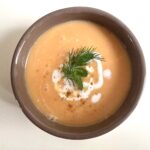 A nice warm bowl of silky-smooth soup of sweet potato and leek with coconut milk, lime juice and spices might be just what the doctor ordered as we head into December. I came up with this one when a glitch in this year’s Thanksgiving plans left me with an abundance of uncooked sweet potatoes. It was a cinch to make — took less than half an hour — and the result was a very soothing soup with Asian flavors that was both healthy and economical.
A nice warm bowl of silky-smooth soup of sweet potato and leek with coconut milk, lime juice and spices might be just what the doctor ordered as we head into December. I came up with this one when a glitch in this year’s Thanksgiving plans left me with an abundance of uncooked sweet potatoes. It was a cinch to make — took less than half an hour — and the result was a very soothing soup with Asian flavors that was both healthy and economical.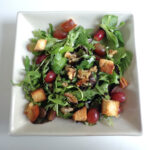 Returning to the sweet potato-leek soup, it may be served at lunchtime, accompanied by sandwiches or a salad, or as a first course for a more elaborate meal. My daughter and I enjoyed it for lunch with
Returning to the sweet potato-leek soup, it may be served at lunchtime, accompanied by sandwiches or a salad, or as a first course for a more elaborate meal. My daughter and I enjoyed it for lunch with 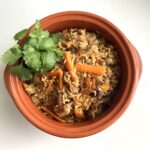 Plov is a rich and spicy rice dish from Central Asia that is traditionally made with lamb, although other meats are sometimes used. The lamb is browned with carrots and onions before being simmered with cumin seeds, paprika and turmeric or saffron. Quince or chickpeas may also be included. A layer of rice studded with whole cloves of garlic is added at the end and steamed to tender perfection to create a festive one-dish meal.
Plov is a rich and spicy rice dish from Central Asia that is traditionally made with lamb, although other meats are sometimes used. The lamb is browned with carrots and onions before being simmered with cumin seeds, paprika and turmeric or saffron. Quince or chickpeas may also be included. A layer of rice studded with whole cloves of garlic is added at the end and steamed to tender perfection to create a festive one-dish meal. P.S. With Thanksgiving around the corner, here are some recipes that could lend a French touch to the festivities:
P.S. With Thanksgiving around the corner, here are some recipes that could lend a French touch to the festivities: 
 If you’d like to try your hand at rendering duck fat, you could start out with one of these recipes:
If you’d like to try your hand at rendering duck fat, you could start out with one of these recipes: 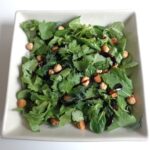 I wanted to make an autumnal salad with hazelnuts and fresh herbs. This, I thought, would be a simple matter. Mais non, mes amis. I made the mistake of starting with hazelnuts still in their peels. Figured it would easy to blanch the nuts and remove the peels. I was wrong. It took me half an hour to rub the peels off just 20 hazelnuts, and the job was imperfect, with stubborn bits clinging on. Then I roasted the nuts, and they burned…
I wanted to make an autumnal salad with hazelnuts and fresh herbs. This, I thought, would be a simple matter. Mais non, mes amis. I made the mistake of starting with hazelnuts still in their peels. Figured it would easy to blanch the nuts and remove the peels. I was wrong. It took me half an hour to rub the peels off just 20 hazelnuts, and the job was imperfect, with stubborn bits clinging on. Then I roasted the nuts, and they burned… One of the simplest weeknight dinners I know is baked fish, in this case fillets of haddock with homemade tartar sauce, French style. The fish is dusted with salt, pepper and a little cumin — no flour is involved — and drizzled with olive oil before being roasted in a hot oven for 10-15 minutes, depending on the thickness of the fillets. While the fish is cooking you can whip up the tartar sauce, and presto. Dinner is ready in less than half an hour.
One of the simplest weeknight dinners I know is baked fish, in this case fillets of haddock with homemade tartar sauce, French style. The fish is dusted with salt, pepper and a little cumin — no flour is involved — and drizzled with olive oil before being roasted in a hot oven for 10-15 minutes, depending on the thickness of the fillets. While the fish is cooking you can whip up the tartar sauce, and presto. Dinner is ready in less than half an hour. The answer, mes amis, is that they mean ‘smoked haddock’, which is sold here in bright yellow-orange skin-on fillets. But not to panic. This recipe calls not for haddock (pronounced ah-DUCK), but rather for églefin, or ‘fresh haddock’.
The answer, mes amis, is that they mean ‘smoked haddock’, which is sold here in bright yellow-orange skin-on fillets. But not to panic. This recipe calls not for haddock (pronounced ah-DUCK), but rather for églefin, or ‘fresh haddock’. Oddly, the word églefin derives from a Dutch word, schelvisch, which looks more like shellfish to me. But languages evolve in mysterious ways, and somehow over the centuries the word changed to something that sounds far more French — égle evoking aigle, or ‘eagle’, and fin meaning ‘fine’ or ‘thin’…
Oddly, the word églefin derives from a Dutch word, schelvisch, which looks more like shellfish to me. But languages evolve in mysterious ways, and somehow over the centuries the word changed to something that sounds far more French — égle evoking aigle, or ‘eagle’, and fin meaning ‘fine’ or ‘thin’… Ok, now on to the sauce. How is French sauce tartare different from the tartar sauce served, say, in the States or in England? Well, for one thing it isn’t sweet. For another it uses capers and can dispense with pickles or pickle relish altogether. This produces a more sophisticated flavor, in my view.
Ok, now on to the sauce. How is French sauce tartare different from the tartar sauce served, say, in the States or in England? Well, for one thing it isn’t sweet. For another it uses capers and can dispense with pickles or pickle relish altogether. This produces a more sophisticated flavor, in my view.

